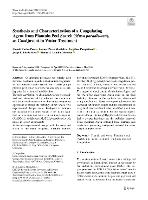Resumen
Coagulation processes are widely used
for water treatment, mainly with chemical coagulants.
In this research, starch derived from a waste (unripe
plantain peel, Musa paradisiaca) was used as a starting point for a chemical modifcation.
Through acetylation, its chemical structure was modifed and characterized by infrared spectrophotometry, for its evaluation as a coadjuvant in coagulation
operations to reduce the turbidity of raw water. Two
experimental designs were developed to evaluate
the incidence of modifed starch as the main coagulant, or in conjunction with a conventional coagulant
(Al2(SO4)3), at diferent (Al2(SO4)3)/acetylated starch
ratios, in jar-test experiments.
In the frst experimental design, with the acetylated
starch as the main coagulant, turbidity removal
percentages reached 47.93% (average value, 41.18%).
For the (Al2(SO4)3)/acetylated starch coagulation process, 98.91% turbidity removal was reached in the
second experimental design (average value, 97.16%).
The impact of starch chemical substitution degree and
the (Al2(SO4)3)/acetylated starch ratio on the fnal
turbidity obtained in the jar-tests was determined
using ANOVA test. There was a great infuence of the
chemical substitution degree and the concentration of
acetylated starch utilized, when modifed starch was
used as the main coagulant. For the second experimental design, the (Al2(SO4)3)/acetylated starch ratio
had a greater incidence on the turbidity removal.
Thus, modifed starch obtained from plantain peel
waste is a promising coadjuvant material for water
coagulation processes.














